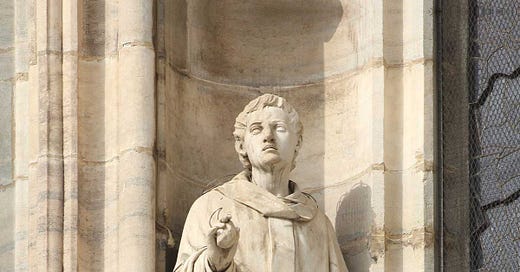Traditional sources do not reveal many details about St Stephen’s early life. Some texts suggest he was a Jew, and even may have been one of the Seventy disciplines whom Jesus sent out. The most reliable parts of his story come from the Acts of the Apostles in the Bible.
Stephen was chosen as a deacon to serve the non-Jewish Christian widows. He was described as a man full of faith and the Holy Spirit.
Acts 6 v 5
They chose Stephen, a man full of faith and of the Holy Spirit.
In verse 8, how is described as full of grace and power, performing signs and wonders.
Stephen then upset the Synagogue of the Freedmen from Cyrene, Alexandria, and those from the provinces of Cilicia and Asia (Turkey). This synagogue was likely Jews who had been slaves in the distant parts of the Roman Empire and then became free. They had returned to Jerusalem and met at a particular synagogue.
They argued with Stephen, but could not overcome his wisdom or the Holy Spirit within him. So they lied about how he had blasphemed against Moses.
Stephen was arrested and brought before the Sanhedrin. This was an assembly who would rule on the Jewish customs. The Romans gave the court some powers of punishment.
False witnesses were brought to condemn him, but Stephen gave an apologetic speech. He ended it by criticising the elders, and saying that he saw a vision of Jesus Christ standing at the right hand of God.
At this comment, they dragged Stephen outside the city walls and stoned him until he was dead.
Acts 7 v 55-56
But Stephen, full of the Holy Spirit, looked intently into heaven and saw the glory of God and Jesus standing at the right hand of God. “Look,” he said, “I see heaven open and the Son of Man standing at the right hand of God.”
The Son of Man is a key statement in the text, as it is how Jesus referred to Himself. It comes from the Book of Daniel.
Daniel 7 v 13
In my vision in the night I continued to watch, and I saw One like the Son of Man coming with the clouds of heaven.
Here, the Son of Man is given dominion and authority over all nations and languages.
This led to the 1st Century Jewish theology called the ‘Two Powers in Heaven’. This was a widely held belief amongst the Pharisees, in which there were two thrones in Heaven, one occupied by God and the other occupied by a yet unknown person.
When Jesus told the High Priest that He is the Son of Man, the priest tore his clothes and condemned Jesus to death for blasphemy.
Mark 14 v 62
“I am,” said Jesus. “And you will see the Son of Man sitting at the right hand of the Mighty One and coming on the clouds of heaven.”
This theological idea was banned by the Jewish authorities after the death and resurrection of Jesus.
Stephen confirmed the position of Jesus in Heaven and the prophecy in Daniel. Like Christ, Stephen was condemned to death for uttering the same idea.
In the story, it is mentioned that Stephen’s face was like an angel.
Acts 6 v 15
All who were sitting in the Sanhedrin looked intently at Stephen, and they saw that his face was like the face of an angel.
Maybe Luke is telling us that Stephen is symbolically like a messenger of God. After all, angel means ‘messenger’.
A further thought relates to the idea that one of the Old Testament names for the archangels was ‘sons of God’.
In John 1 v 12, we are told that those who believe in Jesus can become children or sons of God. So this implies Christians will replace the fallen angels. By Luke suggesting Stephen had a face like that of angel, he was saying that he was like a child of God.
In verse 54, the priests gnash their teeth.
Acts 7 v 54
When the members of the Sanhedrin heard this, they were furious and gnashed their teeth at him.
This ‘gnashing of teeth’ links in with the wicked and is also the action of those who are cast into Hell.
Psalm 37 v 12
The wicked plot against the righteous and gnash their teeth at them;
The priests prosecuted Stephen, but by their actions, they were the ones condemned as enemies of God.
Stephen’s martyrdom is commemorated on December 26 and is often called St. Stephen’s Day. This is famously references in the Christmas Carol “Good King Wenceslas”.
Stephen became an inspiration to the early Church, especially in the years of persecution. How he forgave his persecutors reflected Jesus’ example on the Cross.
Acts of the Apostle mentions St Paul looked after the coats of Stephen’s executioners. Even though he wasn’t directly involved in the martyrs death, Paul must have been influenced by what he saw. Firstly, to go on a crusade to persecute Christians across the Empire, and then to pursue Christ and His Gospel.
St Stephen, the first martyr, is a truly an inspiration to all Christians, not just for his eloquent defence of Christianity, but also his devotion into death.




